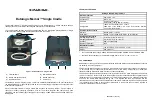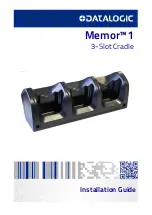
Basic Weather Station BWS-200
2
Manual for the Wind Sentry Wind and Direction Sensor which is fitted as
standard
Manual for the optional ARG100 Raingauge if ordered with your BWS200
manual for the optional CS300 Solar Radiation sensor if ordered with your
BWS200
Manual for the CS100 Barometric Pressure sensor if ordered with your
BWS200
Disk containing a full version of PC200W software
Disk containing a copy of the program running in your BWS200
1.2 Component Parts
Carefully unpack your equipment and check you have the following:
0
3002-5
Wind Sentry C/W junction box
Adapter ¾ pipe for 0
3002-5
Wind Sentry
Clamp M6 `V’ bolt
Clamp V bracket
Desiccant Desipack 4 units
BWS200 Support Software (CD)
PC200W Starter Software for Windows (CD-Rom)
BWS200 Enclosure with logger and power supply
Are any components missing or damaged?
Do you have all the necessary tools for assembly?
Refer to Sections 4.1 and 4.2.
2. Choosing the Location
For optimum results, the siting of the Basic Weather Station is crucial. This section
briefly describes several factors which can affect the results obtained. Please read
through this information before deciding where to locate your weather station, and
try to minimise as many factors as possible that may adversely affect your data.
The objective of any data collection exercise is to obtain data that is accurate,
reliable and representative. Accuracy and reliability depend mostly on the correct
selection and use of sensors. Data representativeness refers to the extent to which
the values recorded are typical of the site or location in which the sensors are
placed.
Weather stations are often used to provide local meteorological measurements that
otherwise could only be obtained from a ‘standard’ meteorological site, perhaps
some inconvenient distance away. In this case the weather station should be
exposed in a similar way to the instruments on the standard site, i.e. over a short
grass surface that is level and not shielded by trees or buildings. The standard
site
is designed to allow representative measurements of local weather and not of a
specific microclimate.
In other cases, a weather station is required to measure the true conditions at a site
— possibly to determine how much these differ from the standard conditions
measured over a regional network of meteorological stations. Here, the weather
station should be exposed over a relatively uniform area of terrain. Some care is
required in interpreting the measurements obtained, however, because gradients of
air temperature, humidity and wind speed increase as the distance from the surface
decreases.













































